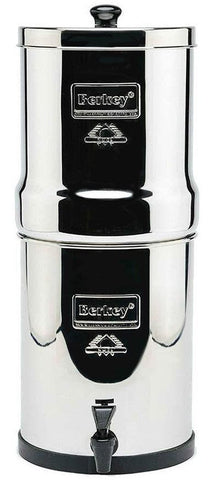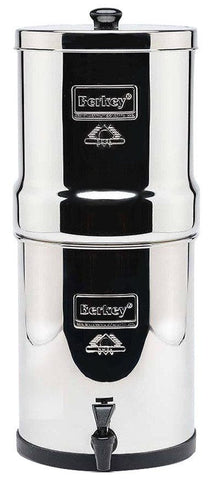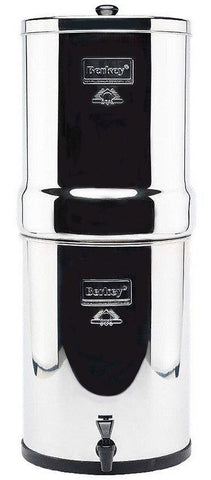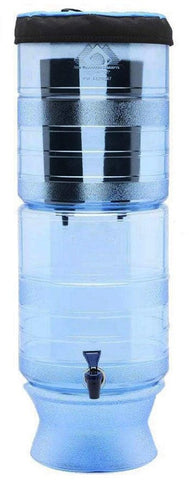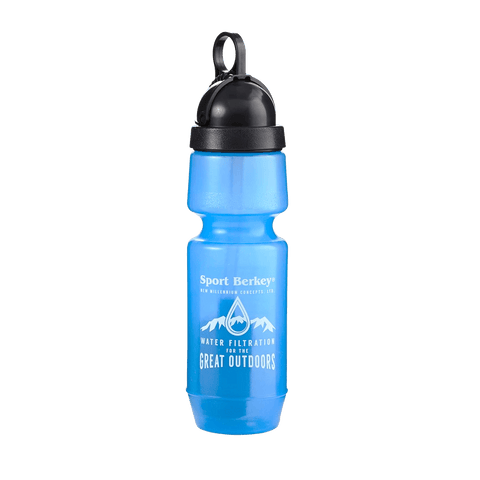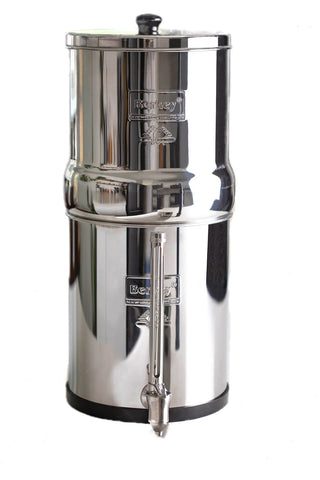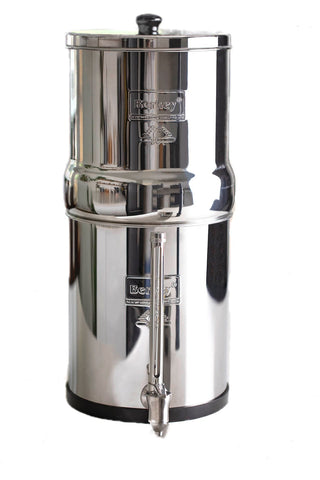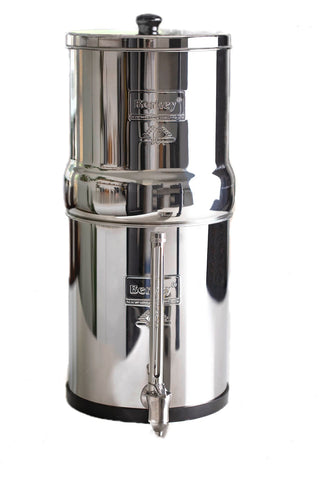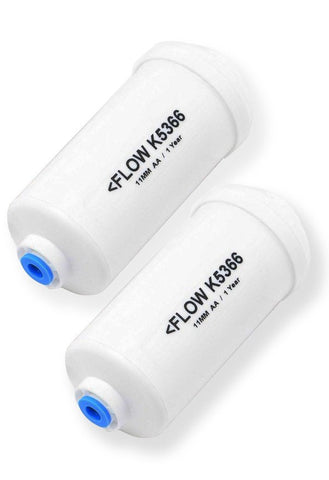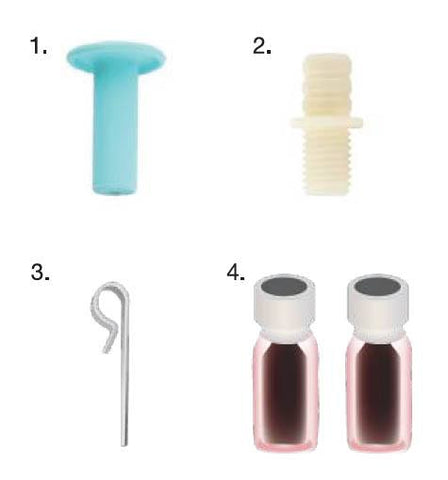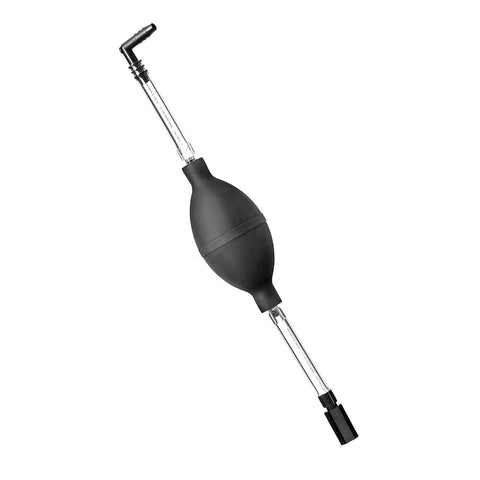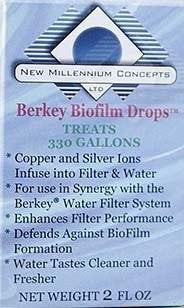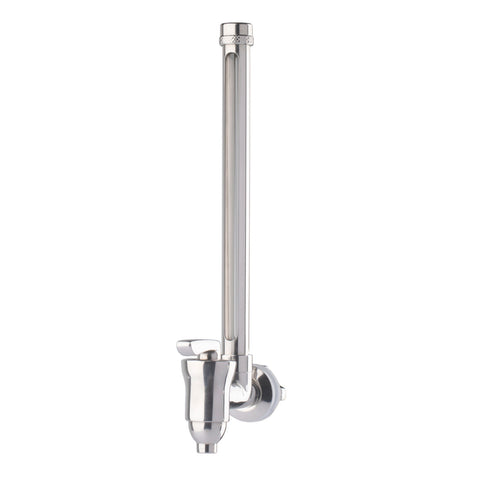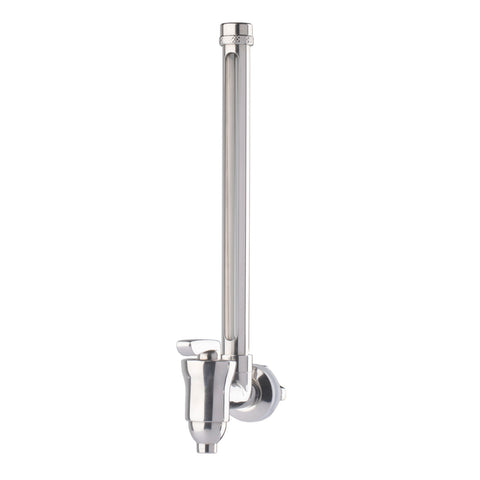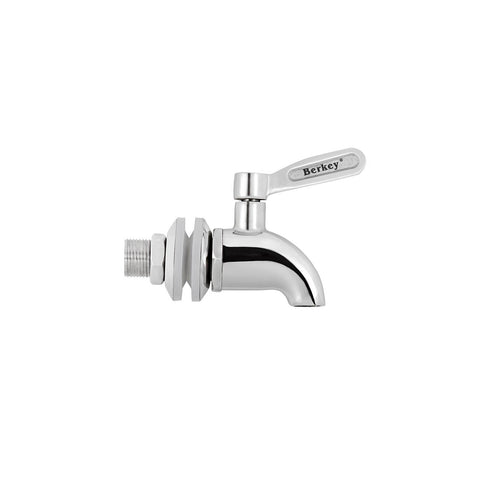Berkey Water Filter - The Best Gravity Water Filters
Berkey Best Sellers
Accessories
Why Berkey? What makes Berkey water filters so special?

♛ Berkey Works Better Than Any Gravity Filters Available!
Berkey® systems equipped with Black Berkey Elements dramatically reduce trihalomethanes, inorganic minerals, heavy metals, pharmaceuticals, pesticides, VOCs, petroleum products, perfluorinated chemicals, rust, silt, sediment, radiologicals, and more.
Berkey Water Filter can remove hundreds of contaminants from the water and filter more than any other gravity filter available. Berkey filters produce the most Healthful Drinking Water available. Black Berkey Elements exceed EPA 7 ANSI/NSF Protocols and are Independently Tested by EPA/NSF Certified Lab. The Black Berkey Elements are made and assembled in the USA.
♛ Berkey Makes Your Water Taste Delicious
Berkey Water Filter makes your water taste much better by filtering out all toxins but leaving the minerals in the water as they should be. You will notice a difference right away.
♛ Berkey For Emergency Preparedness
Berkey Water Filter is a great survival gear in emergencies as it works without electricity. Berkey is ideal for use with freshwater sources.
♛ Berkey Saves Your Money
Berkey Water Filter is the most economical water filtration system available as you can filter water for about three cents per gallon, which will last for years.
♛ Berkey is Simple and Easy
Berkey Water Filter does not require to be connected to your home plumbing system. A complete standalone system can be set up in less than 10 minutes without any tools.
Berkey systems have become the leader in gravity-fed water filtration.

What is a Berkey Water Filter? Berkey Water Filter is one of the most effective and cost-effective personal gravity water filtration systems. It uses gravity water filtration technology to dramatically reduce trihalomethanes, inorganic minerals, heavy metals, pharmaceuticals, pesticides, VOCs, petroleum products, perfluorinated chemicals, rust, silt, sediment, radiologicals without removing the beneficial minerals and using any electricity.
Berkey offers options to fit every family size and budget. They fit easily in most kitchens. Berkey systems can efficiently filter ordinary tap water or freshwater sources. Berkey systems can be used during power outages, outdoor camping, or unexpected events.
Berkey Systems are the best way to ensure your family has a constant supply of fresh drinking water.
Berkey Water Filter Systems are Top-sellers For a Reason.
Our products are long-lasting (6,000 Gallons for a pair of the Black Berkey Elements Filters) and easy to install. The Black Berkey Elements are made and assembled in the USA.
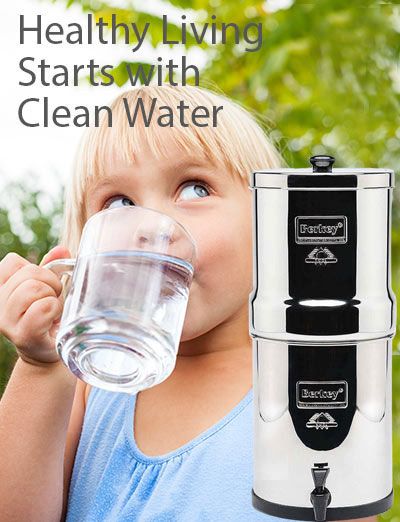
Black Berkey dramatically reduce trihalomethanes, inorganic minerals, heavy metals, pharmaceuticals, pesticides, VOCs, petroleum products, perfluorinated chemicals, rust, silt, sediment, radiologicals, and more without removing the beneficial and nutritional minerals needed to support a healthy body and mind.
The Black Berkey Element formulation has been tested by State and EPA-accredited laboratories to exceed NSF/ANSI Standard 53.
The Black Berkey Elements are crafted from a unique blend of materials that target specific contaminants, surpassing the filtering capabilities of those made purely from ceramic or activated carbon. Third-party testing has confirmed their effectiveness, establishing them as the gold standard for gravity-fed water filtration. They have a longer lifespan than most filter elements on the market, while being incredibly cost-effective, costing mere pennies per gallon of filtered water. With Berkey systems equipped with Black Berkey Elements, the reduction in contaminants is significant.
If you're concerned about Fluoride and seeking to remove Fluoride from the water,
get our Fluoride Removal Filters PF-2 which can reduce Fluoride and Arsenic by over 95%.
Berkey Water Filters can remove
|
|
|

Berkey Water Filters are the world's most effective and cost-effective personal gravity water filtration systems.
Berkey Water Filters for Emergency Preparedness
Berkey Water Filter is the most preferred drinking water filter in remote areas and places with no tap water available but only freshwater sources.
You pour water straight from the upper chamber of stainless water containers then safe and filtered drinking water is now stored in the lower chamber, ready for drinking.
Berkey water filters are the best choice because they are easy to use even without electricity and are simple, healthy, efficient, cost-friendly, eco-wise, and highly reliable.
Access to accessible drinking water becomes urgent during an emergency or natural disaster. Berkey systems are ideal water filtration systems when treated tap water may not be available.
The Federal Emergency Management Agency recommends that every household develop an emergency preparedness kit that includes food and water for each family member for several days.
Gravity filtration has been used by relief organizations such as UNICEF, the Peace Corps, Red Cross Societies Internationally, missionaries, and relief workers worldwide. With the Berkey system of gravity filtration, you can obtain safe drinking water after emergencies such as blackouts, hurricanes, floods, and earthquakes.
Berkey water filters are utilized worldwide to set the international standard for water filters used in clean or hostile filtration environments.
Owning a Berkey Water Filter allows you to use many outside natural water sources and revolutionize it into the best tasting, natural drinking water possible.
Comparison of Berkey Water to Reverse Osmosis
Based on current research, many health experts no longer recommend drinking Reverse Osmosis or Distilled water long-term because these methods strip out all the beneficial minerals from the water, making the water an acidic “hypotonic” solution.
Berkey Water Filter Systems do not remove all beneficial minerals from the water. Still, they extract harmful heavy metals such as lead and mercury and sedimentary minerals such as iron oxide. Therefore, the TDS reading will not typically change much unless there are a lot of heavy metals or sedimentary minerals within the source water.
Reverse Osmosis systems typically are the most expensive due to the cost of the system and the additional expense of having the system plumbed in. Reverse Osmosis systems that are adequately maintained typically cost between 45-75 cents per gallon. A Berkey system typically costs about 3.8 cents per gallon.
Why You Need Water Filters
Berkey systems are the leading gravity-fed water filtration solution for outdoor enthusiasts, self-reliant homes, missionaries abroad, relief organizations, and health-aware individuals and families worldwide.
Water that is left untreated is hazardous to drink. The ones that have not gone through the process of filtration will result in severe complications in the body. Many illnesses can result from drinking contaminated water.
Some older houses could have old pipes and plumbing systems that can introduce copper and other contaminants into the water supply. Even though your local water supply is treated, these contaminants may be able to enter your home as water flows through old, corroded pipes. Filtering your water helps keep these materials out of your drinking water.
Common Contaminants
-
Heavy Metals. Once water is contaminated through this, it can result in kidney problems and even cancer. Elements that belong under this contaminant are zinc, Arsenic, mercury, and lead.
-
Feces. This is self-explanatory as to how this can harm a person's health once carried inside the body. Regardless of whether it is of a person or animal' still, it is very unsanitary.
- Petroleum. This can contaminate our waters through the oil spills and leakages that occur. Crude Oil is a typical example that mostly contaminates our drinking water.
These are only a few but the most common ones endangering our water's reliability. We must be mindful of other contaminants: pharmaceutical drugs and medicines, sewage leaks, and industrial waste.
Here are some of the reasons why you need to have the Berkey Water Filter:
To Remove Chlorine From Water
A lot of cities all over the world make use of chlorine to clean their water supply. Although this process is essential to ensure that we have clean drinking water free from microorganisms that could badly affect our health, chlorine is basically bleach and carries many health risks. It even increases your risk of developing bladder and rectal cancer.
Most water utility companies choose to use chlorine to clean tap water because it's easy to use, inexpensive, and very effective in killing off bacteria found in the water. Chlorine can also be very effective in eliminating viruses in the water.
Although chlorine is a good and effective disinfectant, it can make your drinking water smell and taste bad. Your water could be very unpleasant. The chlorine could also react with other metals that can be found in the water, therefore, forming a hazardous compound.
Black Berkey Filters can remove 99.9%, and Berkey Shower Filters can remove 95% chlorine.
To Remove Fluoride From Water
We only need a small amount of the mineral fluoride. Fluoride started being added to public water in the 1940s in the united states to improve dental health. An excessive amount of it can be toxic, especially to children under eight.
Fluoride is most well-known for tooth decay prevention. Fluoride is added to most toothpaste, soil fertilizers, and even water systems, that had caused an alarm worldwide. This act makes users prone to overconsumption of the mineral, which can cause severe health damage. Anything in excess is not beneficial.
Irrefutable evidence shows that high fluoride consumption is directly associated with gastrointestinal problems, low fertility, thyroid and endocrine-related ailments, and even cancer.
Though the Black Berkey Filters alone can remove up to 99.99% of fluoride for a short period, for extra protection, Berkey Fluoride Filters PF-2 can remove up to 97% of fluoride from tap water for up to 1,000 gallons.
To Remove Lead From Water
Lead in drinking water is one of the greatest environmental threats we face. Lead must be removed from your water because it could be toxic when ingested. Lead is a toxic metal that can harm human health even at low exposure levels. Lead is persistent, and it can bioaccumulate in the body over time. Lead could commonly get into your drinking water by seeping into your water supply through the old plumbing pipelines or the solder used to join together.
Lead can be removed from the water when you let the water pass through a filter that uses a reverse osmosis mechanism, a carbon filter, or distillation that was specifically designed to remove the metal from your drinking water.
If your primary water source is a well, health authorities recommend that you have the water tested at least once a year for any lead or other kinds of contaminants.
Over the past decade, epidemiological studies have consistently demonstrated no safe lead level. In particular, studies conducted on diverse populations of children consistently show the harmful effects of lead exposure on cognitive function, as measured by IQ decrements, decreased academic performance, and poorer performance on tests of executive function. Lead exposure is also associated with decreased attention, impulsivity, and hyperactivity in children.
Berkey water filters can remove lead by at least 99.9% from drinking water.
To Remove Arsenic From Water
Arsenic is a natural chemical that can be present in groundwater. Arsenic ingestion can only pose health issues when a dangerous quantity of Arsenic has entered the body. After that, poisoning can lead to liver disease, cancer, coma, or even death.
According to the World Health Organization, a non-government agency, Arsenic is one of the major causes of poisoning and death since Arsenic is naturally found in groundwater, which is the source of drinking water in some undeveloped countries in the world.
Long-term arsenic ingestion from drinking water is highly associated with a greater risk of skin cancer. There is substantial evidence that it increases the risk for bladder, lung, kidney, liver, colon, and prostate cancers.
Berkey filters can remove 99.9% of Arsenic from the water.
To Remove Chromium 6 From Water
Chromium 6, also known as hexavalent chromium, is a highly toxic compound found to cause allergic dermatitis and stomach and gastrointestinal cancer in humans and animals.
Chromium 6 is a chemical element that contains chromium in the +6 oxidation state and is a tasteless and odorless metallic compound usually found in soil, plants, rocks, volcanic particles, and even animals.
Further research and studies are continuously being conducted to determine the specific health risks that Chromium 6 can bring upon ingestion through drinking water. For now, Chromium 6 is identified as a human carcinogen, which means it promotes cancer formation.
Chromium-6 could have been in your drinking water for years, even long after it’s no longer added through industrial processes.
Using Black Berkey filters, Berkey water filter systems can remove more than 99.8% of Chromium-6.
To Remove Glyphosate From Water
Glyphosate is a chemical found in weed killer, one of today's most widely used pesticides. Glyphosate can enter tap water through soil erosion and agricultural runoff. Besides agriculture, Glyphosate is also used in gardens, parks, roads, railways, tracks, and cemeteries.
According to the US Environmental Protection Agency (EPA), there are no risks or concerns to human health from the current uses of Glyphosate. The studies conducted did not find Glyphosate to be a human carcinogen. However, data from other sources, such as the International Agency for Research on Cancer (IARC), suggest Glyphosate is a possible human carcinogen.
The Berkey Water Filter can remove over 75% of Glyphosate, exceeding the laboratory reporting limits.
To Remove Haloacetic Acids From Water
Haloacetic acids (halogenated acetic acids, HAAs, or HAA5) are chemical compounds that can build up because of water treatment when water acidity and temperature are marginally high, and treatment chemicals react with organic particles or bromide. They can happen during water treatment, including chlorination, chloramination, or ozonation.
In some studies, exposure to disinfectant byproducts, including Haloacetic acids HAA5, increased the incidence of bladder cancer.
Berkey Filters can remove 99.9% of Haloacetic acids HAA5.
To Remove Radium and Uranium From Water
The radionuclides from the decay of thorium-232 and uranium-238 are extensively distributed through the earth's crust. Many of them are known as alpha emitters. It includes radon, polonium, as well as Radium.
Studies have shown that natural alpha emitters are bone seekers in drinking water. As such, radium -226 and radium -228 can potentially produce harmful radiation doses. Exposure to high radionuclides levels can result in toxic kidney effects and an increased risk of cancer.
Berkey filters can remove at least 98.7% of Uranium combined (pCi/L) and Radium combined (-226 & -228) from drinking water.
To Remove Microplastics From Water
Microplastics (microscopic plastic) are particles smaller than 5 mm in size that can be found in various places. In the global study, microplastics are found in 93% of bottled water tested.
Microplastics have been detected in drinking water, beer, and food products, including seafood and table salt.
The Black Berkey Filters have not been tested to remove microscopic plastic fibers. However, it suggests that contaminants much larger in size, such as plastic fibers, would be removed since the Black Berkey filters can reduce viruses down to the nanometer scale, in the tested range of 24-26 nanometers smaller than the plastic particles being found in water.
What Is Special About Berkey Water Filter?
Our unique Black Berkey® Elements are made from a proprietary blend of media designed to work synergistically and target specific contaminants that far exceed the reduction capabilities of filters that are solely composed of activated carbon or ceramic materials, and are backed by independent third-party testing.
The gold standard in gravity-fed water filtration, authentic Black Berkey® Elements are capable of greater contaminant reduction and a longer lifespan than virtually any of the other filter elements on the market, and are an economical choice, averaging just pennies per gallon of filtered water.
Berkey® systems equipped with Black Berkey® Elements dramatically reduce trihalomethanes, inorganic minerals, heavy metals, pharmaceuticals, pesticides, VOCs, petroleum products, perfluorinated chemicals, rust, silt, sediment, radiologicals, and more.
Berkey® systems are used every day in homes around the world by discerning consumers who trust the quality of Berkey® systems to meet their drinking water needs. We recommend replacing Black Berkey® Elements every 3,000 gallons (6,000 per set of 2 elements). Elements may require replacement sooner based upon the quality of influent water.
Models and Specifications
The Berkey filtration systems come in 7 different sizes – or models. The systems are identical apart from their storage capacity and maximum filtration rate. They all use the same Black Berkey® Elements Filters.

Travel Berkey Water Filter
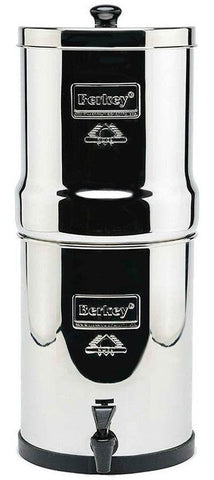 The 1.5-gallon water tank is ideal for one or two people or a camping trip. The Travel Berkey is 18″ high, although it can be collapsed to 12″ for storage. It has a 7.5″ diameter. It can hold a maximum of two filters which will filter up to 2.5 gallons of water per hour.
The 1.5-gallon water tank is ideal for one or two people or a camping trip. The Travel Berkey is 18″ high, although it can be collapsed to 12″ for storage. It has a 7.5″ diameter. It can hold a maximum of two filters which will filter up to 2.5 gallons of water per hour.
- Stores Easily - Reduces to 8 X 12 inches.
- Compact - Stands 18” high when in use.
- Stores 1.5 gallons of filtered water in the lower chamber
- 2.75 gallons per hour flow rate - 60 gallons per day if the upper chamber is kept full
- Long Life - filter up to approximately 6,000 gallons of tap water
Singles or Couples at Home
Top your Travel Berkey off at the end of the day, and you have safe fresh-tasting water in the morning.
Ideal Travel Companion
No matter where you roam, the Travel Berkey will help keep you safe from the risks associated with contaminated water.
Big Berkey Water Filter
 The 2.25-gallon water tank is a good size for most average families. The Big Berkey is 19″ tall and has a diameter of 8.5″. It can hold a maximum of four filters. The filtration time per hour varies depending on how many filters you install.
The 2.25-gallon water tank is a good size for most average families. The Big Berkey is 19″ tall and has a diameter of 8.5″. It can hold a maximum of four filters. The filtration time per hour varies depending on how many filters you install.
- Reduces to a compact 8 X 13 inches
- Stands 19.5” high when in use and is 8” in diameter
- Can store 2.25 gallons of filtered water in the lower chamber
- Comes with two Black Berkey filter elements
- Flow rate of about 4 gallons per hour (60 gallons per day) with two filter elements
- Can filter up to approximately 6,000 gallons of tap water
Royal Berkey Water Filter
 With a 3.25-gallon water tank, the Royal Berkey is a good fit for larger families or small businesses. This system is 23″ tall and has a 9.5″ diameter. It can hold a maximum of four filters, and filtration time depends on how many filters you choose.
With a 3.25-gallon water tank, the Royal Berkey is a good fit for larger families or small businesses. This system is 23″ tall and has a 9.5″ diameter. It can hold a maximum of four filters, and filtration time depends on how many filters you choose.
- Reduces to a compact 8 X 13 inches
- Stands 19.5” high when in use and is 8” in diameter
- Can store 3.25 gallons of filtered water in the lower chamber
- Comes with two Black Berkey filter elements
- Flow rate of about 4 gallons per hour (60 gallons per day) with two filter elements
- Can filter up to approximately 6,000 gallons of tap water (no other filter comes close)
Imperial Berkey Water Filter
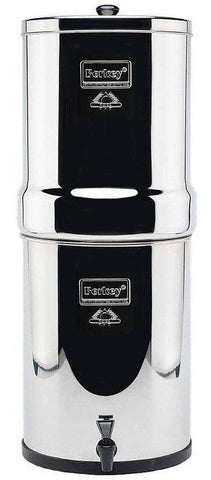 Featuring a hefty 4.5-gallon water tank, the Imperial Berkey is twice the size of the Travel Berkey. That makes it a good fit for large families who drink water or small offices. The Imperial Berkey is 25.75″ tall and has a 10″ diameter. It can hold a maximum of 6 filters and filtration time per hour depends on how many filters you choose to install.
Featuring a hefty 4.5-gallon water tank, the Imperial Berkey is twice the size of the Travel Berkey. That makes it a good fit for large families who drink water or small offices. The Imperial Berkey is 25.75″ tall and has a 10″ diameter. It can hold a maximum of 6 filters and filtration time per hour depends on how many filters you choose to install.
- Reduces to a compact 10 by 17 inches
- Stands 25” high when in use
- Can store 4.5 gallons of filtered water in the lower chamber
- Flow rate of about 5.5 gallons per hour (125 gallons per day) with two filter elements
- Can filter up to approximately 6,000 gallons of tap water (no other filter comes close)
- Comes with two Black Berkey Filter Elements
Crown Berkey Water Filter
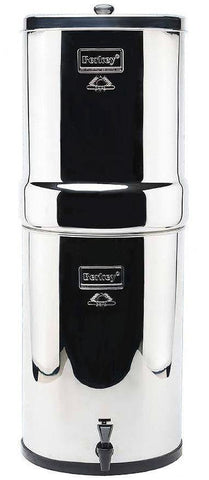 With a massive 6-gallon water tank, the Crown Berkey is certainly the king of the Berkey family of water filters. Crown Berkey is 30″ tall and 11″ in diameter. It weighs 12.6 pounds and can filter 6.5 gallons per hour.
With a massive 6-gallon water tank, the Crown Berkey is certainly the king of the Berkey family of water filters. Crown Berkey is 30″ tall and 11″ in diameter. It weighs 12.6 pounds and can filter 6.5 gallons per hour.
- Reduces to a compact 11 X 20 inches for storage or transport
- Stands 30” high when in use
- Can store 6 gallons of filtered water in the lower chamber
- Flow rate of about 6.5 gallons per hour (125 gallons per day) with two filter elements
- Can filter up to approximately 6,000 gallons of tap water (no other filter comes close)
- Comes with Two Black Berkey Filter Elements
Berkey Light Water Filter
 The Berkey Light is a see-through, more portable, lightweight alternative to the stainless steel models with the same filtration abilities. The Berkey Light weighs only six pounds, yet it can hold up to 2.75 gallons of filtered water. Great for home use, travel, on the go activities, and unexpected emergencies.
The Berkey Light is a see-through, more portable, lightweight alternative to the stainless steel models with the same filtration abilities. The Berkey Light weighs only six pounds, yet it can hold up to 2.75 gallons of filtered water. Great for home use, travel, on the go activities, and unexpected emergencies.
- Comes with 2 Black Berkey Elements (expanded up to 4)
- Constructed of a non-BPA/BPS co-polyester, which does not retain or leach any foul odors into your water
- Storage capacity of about 2.75 gallons (10.4 liters)
- Height when in use: 21" (when used without base); 26.5" (with base)
- Weight: 6lbs empty
- For normal everyday use, this system easily serves: 1-5 people
- Fully configured, this system can serve up to 100-200 people a day during an emergency
GO Berkey Kit
 The Go Berkey Kit is designed for camping, backpacking, school, on your desk at work, travel, in times of emergency, or other on the go activities. It is lightweight and easily transportable. The Go Berkey system uses the same powerful Black Berkey filter.
The Go Berkey Kit is designed for camping, backpacking, school, on your desk at work, travel, in times of emergency, or other on the go activities. It is lightweight and easily transportable. The Go Berkey system uses the same powerful Black Berkey filter.
- Storage capacity of about 1 quart (.95 liters)
- Height when in use: 14” (only 10” in height for transport)
- Diameter: 4"
- Weight: 2.4 lbs empty
- Serves: 1 or 2 people
- Comes with 1 Black Berkey Element (Produce up to one gallon of filtered drinking water per hour)
Sport Berkey Water Bottle
 The Sport Berkey Portable Water Filter is the ideal personal protection traveling companion — featuring the IONIC ADSORPTION MICRO FILTRATION SYSTEM.
The Sport Berkey Portable Water Filter is the ideal personal protection traveling companion — featuring the IONIC ADSORPTION MICRO FILTRATION SYSTEM.


